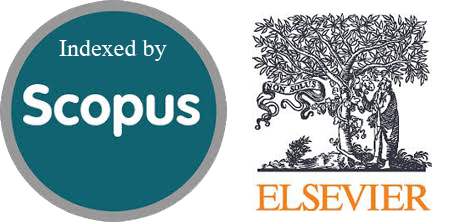Performance Comparison of Monolithic and Microservices Architectures in Handling High-Volume Transactions
Abstract
Monolithic and microservices are two distinct approaches for designing and developing applications. However, these architectures exhibit contrasting characteristics. In monolithic architecture, all components of an application form a unified entity with closely interconnected parts, whereas microservices decompose an application into independent, lightweight services that can be developed, deployed, and updated separately. Microservices are often regarded as superior to monolithic architectures in terms of their performance. This study aims to compare the performance of monolithic and microservices architectures in handling a high volume of transactions. It is important to observe how the two architectures behave when handling transactions from a large number of concurrent users. A prototype of an online ticketing system was implemented for both architectures to enable comparative analysis. The selected performance metrics were response time and error rate. The experimental results reveal that under high-load conditions, microservices outperform monolithic architectures, demonstrating 36% faster response times and 71% fewer errors. However, under overload conditions—when CPU usage exceeds 90%—the performance of microservices degrades significantly. This does not imply that microservices cannot handle a large number of concurrent users but highlights the necessity for enhanced resource management.
Downloads
References
R. Bolscher and M. Daneva, “Designing software architecture to support continuous delivery and DevOps: A systematic literature review,” in ICSOFT 2019 - Proceedings of the 14th International Conference on Software Technologies, SciTePress, 2019, pp. 27–39. doi: 10.5220/0007837000270039.
F. H. Khoso, A. Lakhan, A. A. Arain, M. A. Soomro, S. Z. Nizamani, and K. Kanwar, “A Microservice-Based System for Industrial Internet of Things in Fog-Cloud Assisted Network”, Eng. Technol. Appl. Sci. Res., vol. 11, no. 2, pp. 7029–7032, Apr. 2021. https://doi.org/10.48084/etasr.4077
F. Dai, G. Liu, X. Xu, Q. Mo, Z. Qiang, and Z. Liang, “Compatibility checking for cyber‐physical systems based on microservices,” Softw Pract Exp, vol. 52, no. 11, pp. 2393–2410, Nov. 2022, doi: 10.1002/spe.3131.
P. Di Francesco, P. Lago, and I. Malavolta, “Architecting with microservices: A systematic mapping study,” Journal of Systems and Software, vol. 150, pp. 77–97, Apr. 2019, doi: 10.1016/j.jss.2019.01.001.
S. Hassan, R. Bahsoon, and R. Buyya, “Systematic Scalability Analysis for Microservices Granularity Adaptation Design Decisions,” Softw Pract Exp, 2022, 52(6): 1378–1401, doi: 10.1002/spe.3069.
J. H. Duarte Correia and A. R. Silva, “Identification of Monolith Functionality Refactorings for Microservices Migration,” Softw Pract Exp, 2022, 52(12): 2664–2683, doi: 10.1002/spe.3141.
R. Gebler, “Supporting Regional Pandemic Management by Enabling Self-Service Reporting—A Case Report,” PLoS One, 2024, Jan 31;19(1):e0297039, doi: 10.1371/journal.pone.0297039.
J. Kazanavičius and D. Mažeika, “The Evaluation of Microservice Communication While Decomposing Monoliths”, Comput. Inform., vol. 42, no. 1, pp. 1–36, May 2023. https://doi.org/10.31577/cai_2023_1_1
F. H. Vera-Rivera, C. Gaona, and H. Astudillo, “Defining and measuring microservice granularity—a literature overview,” PeerJ Comput Sci, vol. 7, p. e695, Sep. 2021, doi: 10.7717/peerj-cs.695.
B. Salles and J. Cunha, "Visually-Assisted Decomposition of Monoliths to Microservices," 2023 IEEE Symposium on Visual Languages and Human-Centric Computing (VL/HCC), Washington, DC, USA, 2023, pp. 293-295, doi: 10.1109/VL-HCC57772.2023.00057.
H.-P. Huang, Y.-Y. Fanjiang, C.-H. Hung, H.-F. Tsai, and B.-H. Lin, “Evaluation of a Smart Intercom Microservice System Based on the Cloud of Things,” Electronics (Basel), 2023, vol 12, no. 11 p. 2406, doi: 10.3390/electronics12112406.
S. Hassan et al., “From Monolith to Microservices: Software Architecture for Autonomous UAV Infrastructure Inspection,” Softw Pract Exp, vol. 52, 2022, doi: 10.14569/ijacsa.2017.081236.
J. Kazanavicius et al., “Microservice Identification by Partitioning Monolithic Web Applications Based on Use-Cases,” Softw Pract Exp, 2022, doi: 10.1002/spe.3141.
A. J. Lauwren, “Microservice and Monolith Performance Comparison in Transaction Application,” Proxies Jurnal Informatika, 2024, doi: 10.24167/proxies.v5i2.12447.
G. Blinowski, A. Ojdowska, and A. Przybylek, “Monolithic vs. Microservice Architecture: A Performance and Scalability Evaluation,” IEEE Access, vol. 10, pp. 20357–20374, 2022, doi: 10.1109/ACCESS.2022.3152803.
A. Barczak and M. Barczak, “Performance comparison of monolith and microservices based applications.”, 25th World Multi-Conference on Systemics, Cybernetics and Informatics, WMSCI 2021, vol. 1, pp. 120–125. International Institute of Informatics and Systemics, IIIS.
M. Seedat, Q. Abbas, and N. Ahmad, “Systematic Mapping of Monolithic Applications to Microservices Architecture,” Sep. 2023, [Online]. Available: http://arxiv.org/abs/2309.03796
C. H. Kristantyo, I. A. Putranto, E. S. Soegoto, R. Setiawan, and R. Jumansyah, “Impact of E-Ticketing Application on Bus Transportation in Bandung,” Kne Social Sciences, 2020, doi: 10.2991/aebmr.k.200108.008.
N. Bumanis, G. Vitols, I. Arhipova, and I. Mozga, “Mobile Ticket Lifecycle Management: Case Study of Public Transport in Latvia,” 2017, doi: 10.22616/erdev2017.16.n015.
J. Jordanov and S. K. Jaiswal, “Domain Driven Design Approaches in Cloud Native Service Architecture,” International Journal of Innovative Research in Engineering & Management, 2023, doi: 10.18421/tem124-09.
S. K. Jaiswal, “Domain-Driven Design (DDD)- Bridging the Gap Between Business Requirements and Object-Oriented Modeling,” International Journal of Innovative Research in Engineering & Management, 2024, doi: 10.55524/ijirem.2024.11.2.16.
R. Mikkilineni, “A New Class of Intelligent Machines With Self-Regulating, Event-Driven Process Flows for Designing, Deploying, and Managing Distributed Software Applications,” 2023, doi: 10.20944/preprints202311.1104.v1.
K. Farias and L. Lazzari, “Event-Driven Architecture and REST Architectural Style: An Exploratory Study on Modularity,” Journal of Applied Research and Technology, 2023, doi: 10.22201/icat.24486736e.2023.21.3.1764.
A. Rahmatulloh, F. Nugraha, R. Gunawan, and I. Darmawan, “Event-Driven Architecture to Improve Performance and Scalability in Microservices-Based Systems,” 2022, doi: 10.1109/icadeis56544.2022.10037390.
Ayoubi, “An Event-Driven Service Oriented Architecture Approach for E-Governance Systems,” Kjet, 2019, doi: 10.31841/kjet.2021.1.
R. Bhattacharya and T. Wood, “BLOC: Balancing Load with Overload Control In the Microservices Architecture,” in 2022 IEEE International Conference on Autonomic Computing and Self-Organizing Systems (ACSOS), 2022, pp. 91–100. doi: 10.1109/ACSOS55765.2022.00027.
K. G. Sukadharma, “Implementasi CI/CD Pada Microservices Untuk Meningkatkan Availability Pada Pemrosesan Big Data,” Jeliku (Jurnal Elektronik Ilmu Komputer Udayana), 2024, doi: 10.24843/jlk.2023.v12.i03.p12.
Copyright (c) 2025 Jurnal RESTI (Rekayasa Sistem dan Teknologi Informasi)

This work is licensed under a Creative Commons Attribution 4.0 International License.
Copyright in each article belongs to the author
- The author acknowledges that the RESTI Journal (System Engineering and Information Technology) is the first publisher to publish with a license Creative Commons Attribution 4.0 International License.
- Authors can enter writing separately, arrange the non-exclusive distribution of manuscripts that have been published in this journal into other versions (eg sent to the author's institutional repository, publication in a book, etc.), by acknowledging that the manuscript has been published for the first time in the RESTI (Rekayasa Sistem dan Teknologi Informasi) journal ;







